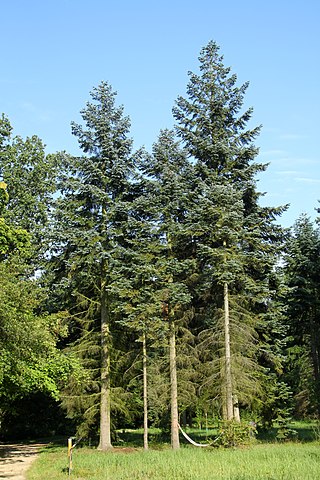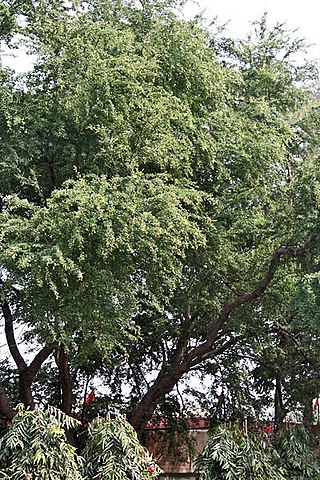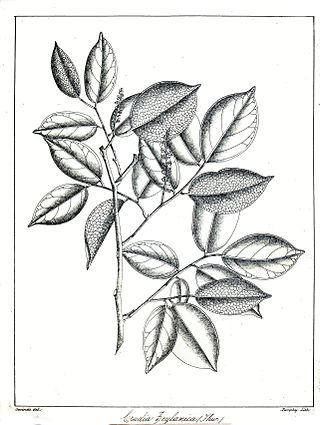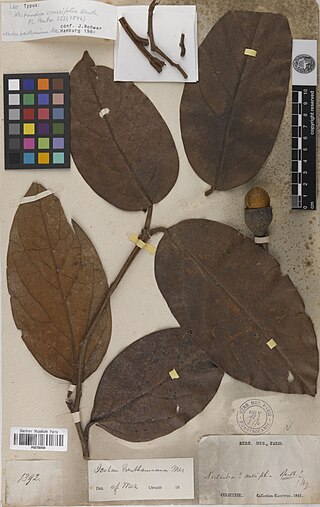
Salix viminalis, the basket willow, common osier or osier, is a species of willow native to Europe, Western Asia, and the Himalayas.

Abies procera, the noble fir, also called red fir and Christmas tree, is a species of fir native to the Cascade Range and Pacific Coast Ranges of the northwestern Pacific Coast of the United States. It occurs at altitudes of 300–1,500 meters (980–4,920 ft).

Leucaena is a genus of flowering plants in the mimosoid clade of the subfamily Caesalpinioideae of the family Fabaceae. It contains about 24 species of trees and shrubs, which are commonly known as leadtrees. They are native to the Americas, ranging from Texas in the United States south to Peru. The generic name is derived from the Greek word λευκός (leukos), meaning "white," referring to the flowers.

Salix miyabeana is a species of willow native to northern Japan. It is a deciduous shrub or small tree, reaching a height of 6–7 m.

Pithecellobium dulce, commonly known as Manila tamarind, Madras thorn, monkeypod tree or camachile, is a species of flowering plant in the pea family, Fabaceae, that is native to the Pacific Coast and adjacent highlands of Mexico, Central America, and northern South America. It is also sometimes known as monkeypod, but that name is also used for several other plants, including Samanea saman. It is an introduced species and extensively naturalized in the Caribbean and Florida, as well as the Philippines and Guam via the Manila galleons. It has also been introduced to Cambodia, Thailand and South Asia, It is considered an invasive species in Hawaii.

Atalaya is a genus of eighteen species of trees and shrubs of the plant family Sapindaceae. As of 2013 fourteen species grow naturally in Australia and in neighbouring New Guinea only one endemic species is known to science. Three species are known growing naturally in southern Africa, including two species endemic to South Africa and one species in South Africa, Eswatini and Mozambique.

Albizia lebbeck is a species of plant in the family Fabaceae, native to the Indian subcontinent and Myanmar. It is widely cultivated and naturalised in other tropical and subtropical regions, including Australia. Common names in English include siris, Indian siris, East Indian walnut, Broome raintree, lebbeck, lebbek tree, frywood, koko and woman's tongue tree. The latter name is a play on the sound the seeds make as they rattle inside the pods. Siris is also a common name of the genus Albizia.
Pseudalbizzia pistaciifolia is a species of plant in the family Fabaceae. It is found in Colombia, Ecuador, and Venezuela.

Crudia zeylanica sometimes known as Sri Lanka legume, is a species of plant in the family Fabaceae endemic to Sri Lanka. Once thought to be extinct, the plant was rediscovered in 2019. The Crudia zeylanica specimen located in the Daraluwa area in Gampaha, was cut down on Tuesday 11 July 2023, what had once been described as the world´s only known wild specimen of a species of legume, part of ongoing construction of a four-lane expressway.
Zygia cognata is a tree species in the legume family (Fabaceae). It is found in Belize, Guatemala, and Honduras.

Hesperocyparis sargentii is a species of conifer in the family Cupressaceae known by the common name Sargent's cypress. It is endemic to California, where it is known from Mendocino County southwards to Santa Barbara County. This taxon is limited to the Coast Range mountains. It grows in forests with other conifers, as well as chaparral and other local mountain habitat, usually in pure stands on serpentine soils. It generally grows 10 to 15 meters tall, but it is known to exceed 22 meters. On Carson Ridge in Marin County, as well as Hood Mountain in Sonoma County, the species comprises a pygmy forest of trees which do not attain heights greater than 240–360 cm due to high mineral concentrations in the serpentine soil.

Ocotea benthamiana is a species of plant in the family Lauraceae. It is a shrub or tree to 15 m tall.

Pentagonia macrophylla is a species of flowering plant in the family Rubiaceae, native from south-eastern Nicaragua to Ecuador. It was first described by George Bentham in 1844.
Myrsine striata is a species of broadleaf evergreen tree in the family Primulaceae. It is endemic to the Western Ghats range in southwestern India, where it grows in submontane evergreen forest. It is known from only two widely-separated sites, one near Mysore in Karnataka.

Quercus lusitanica, commonly known as gall oak, Lusitanian oak, or dyer's oak, is a species of oak native to Portugal, Spain and Morocco. Quercus lusitanica is the source of commercial nutgalls. These galls are produced by the infection from the insect Cynips gallae tinctoriae. They are used for dyeing.

Thelypteris palustris, the marsh fern, or eastern marsh fern, is a species of fern native to eastern North America and across Eurasia. It prefers to grow in swamps, bogs, wet fields or thickets, fresh tidal and nontidal marshes, or wooded streambanks. The species epithet palustris is Latin for "of the marsh" and indicates its common habitat. It is the only known host plant for Fagitana littera, the marsh fern moth.
Beilschmiedia gaboonensis is an evergreen tree in the subgenus Hufelandia of the genus Beilschmiedia, in the family Lauraceae. It is native to central Africa. It is a medium-sized tree which can measure up to 30 m tall with a bole diameter of up to 60 cm. It is distributed from southern Nigeria to the Congo Basin, occurring in Cameroon, Gabon and Zaïre. It is associated with marshy locations in lowland rainforest. Similarly to Beilschmiedia mannii, it is known under the trade names "kanda" and "pink kanda". The bark is used in analgesic and healing ointments.

Lysiphyllum cunninghamii is a species of plant in the family Fabaceae. It is native to northern Australia where it occurs from Western Australia through the Northern Territory to Queensland.

Inga barbata is a species of tree in the family Fabaceae. It was described by English botanist George Bentham. It can be found in Peru and Brazil.
Inga oerstediana is a species of tree in the family Fabaceae. It was described by English botanist George Bentham. It can be found in Mexico, Belize, El Salvador, Honduras, Nicaragua, Costa Rica, Panama, Colombia, Venezuela, Ecuador, Peru, Bolivia, Brazil and Trinidad and Tobago.















